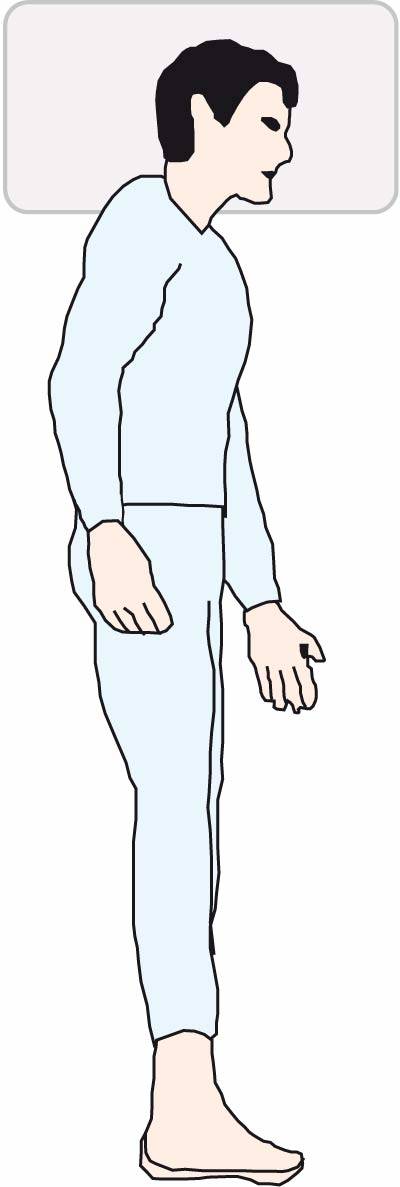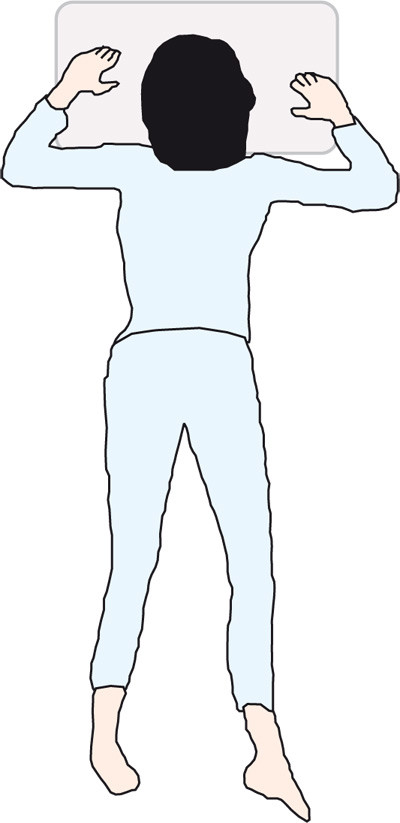Does how we sleep predict how we act? Is one sleep position healthier than another? Many people fall asleep wondering exactly that. The position we sleep in is important as it determines how fresh we feel when we wake up. Most people move around and change positions in their sleep up to 60 times each night. So, the position that you fall asleep in may not be the position in which you spend the majority of the night. Some positions indeed are healthier than the other, as they help our body truly relax without putting undue pressure on any one part.
What’s healthy?
 On your back: Health experts say that the best sleep position is one on your back. Sleeping on your back keeps your head, neck, and spine in alignment. It also reduces acid reflux and aids in digestion, since your head is elevated and your stomach is below your oesophagus. Sleeping on your back is also good for your skin—it helps prevent facial wrinkling and breast sag. On the downside, snoring is more common and severe in those who sleep on their backs.
On your back: Health experts say that the best sleep position is one on your back. Sleeping on your back keeps your head, neck, and spine in alignment. It also reduces acid reflux and aids in digestion, since your head is elevated and your stomach is below your oesophagus. Sleeping on your back is also good for your skin—it helps prevent facial wrinkling and breast sag. On the downside, snoring is more common and severe in those who sleep on their backs.
 On your side: The next best position to sleep in is on your sides. Sleeping on your side elongates your spine, preventing neck and back pain. It also reduces acid reflux, and snoring. This position is good for pregnant women. But sleeping on your side can cause wrinkles on your face. This is because, in this position, your face is in the pillow with your head’s pressure on it.
On your side: The next best position to sleep in is on your sides. Sleeping on your side elongates your spine, preventing neck and back pain. It also reduces acid reflux, and snoring. This position is good for pregnant women. But sleeping on your side can cause wrinkles on your face. This is because, in this position, your face is in the pillow with your head’s pressure on it.The foetal position is an exception to this. However, it is NOT an ideal way to sleep. Reason being, resting in the foetal position, with your knees pulled up and chin tucked in, can cause back pain in the morning. This position may also restrict breathing, since your spine is in a curved position.
 On your stomach: Sleeping on your stomach is the worst way to sleep since it doesn’t keep the spine straight as your head is turned to one side. Sleeping this way puts strain on your joints and muscles [especially the neck], which may cause numbness, pain, and tingling. Sleeping on your stomach is also bad for the skin, but reduces snoring.
On your stomach: Sleeping on your stomach is the worst way to sleep since it doesn’t keep the spine straight as your head is turned to one side. Sleeping this way puts strain on your joints and muscles [especially the neck], which may cause numbness, pain, and tingling. Sleeping on your stomach is also bad for the skin, but reduces snoring.
Position reveals personality
The relationship between sleep position and personality has been a subject of interest for many years. Dr Chris Idzikowski, director of the Edinburgh Sleep Centre, found that people usually fall asleep in six common positions, depending on their personality type. Back in 2003, the research made headlines everywhere as it was one of the few to give insight into the relationship between sleep and personality. Here are the six common positions and the traits they are associated with.
Foetal position: Those who sleep curled up on their sides with knees pulled towards the chest are said to sleep in the foetal position. They are often people who are sensitive yet put up a tough front. They are shy when you first meet them, but eventually relax. Idzikowski found that two times as many women as men slept in this position.
Like a log: If you fall asleep on your side with your arms down at your sides, you sleep in the log position. People who sleep in this position are likely to have an easy-going nature and like to mix with the ‘in-crowd.’ They also trust strangers easily.
The yearner position: In this position, you sleep on your side with your arms stretched out in front of you. Those who fall asleep in this position are of open nature. However, they can sometimes be cynical. Such people find it difficult to arrive at a decision. But once they do decide, they rarely change their minds.
Like a soldier: These are people who sleep on their backs—looking like soldiers standing at attention, with their arms pinned to their sides. These individuals are found to be quiet and reserved. They set high standards and dislike making a fuss.
In a freefall: In this position, both arms are by the head. They may be around the pillow or on it. The head is turned to one side with the weight of the body on the stomach, and the back exposed.
Traits associated with this position are brashness and gregariousness. However, such people can be thin-skinned on the inside and dislike criticism and extreme situations.
Starfish: In this position, people sleep on their backs with their arms up and around the pillow. Such people are usually good listeners, because of which they make good friends. They are also helpful. These people are happier being away from the limelight.
Your sleep buddies
Pillows
- If you sleep on your back, sleep on a puffy pillow. It should support your neck without raising your head too high.
- If you sleep on your side, try a ’side-sleeper‘ pillow. These pillows have two seams so that the edges don’t come to a point, causing neck discomfort. A thick pillow will keep your head and spine in a neutral position while sleeping.
- If you sleep on your stomach, use a thin pillow so you aren’t propped up too much.
When shopping for a pillow, try the ones you like. The pillow should be firm enough to support your head and neck without elevating it unnaturally. Test the quality by folding it in half—if it pops open to its original shape, it is good.
Mattresses
Your mattress may affect which position you end up in.
- Try it out. You won’t know if it suits you unless you test it.
- When lying down, check to see if your head, neck, and spinal cord are aligned the same way they would be if you were standing. The firmness of your mattress doesn’t matter as long as it properly supports you at all contact points.
Ask about the coil count if you’re shopping for an inner spring mattress. The more the coils the better is the mattress. The coils should be pocketed separately. This is good for low motion transfer.
This was first published in the September 2011 issue of Complete Wellbeing
 Spot an error in this article? A typo maybe? Or an incorrect source? Let us know!
Spot an error in this article? A typo maybe? Or an incorrect source? Let us know!
